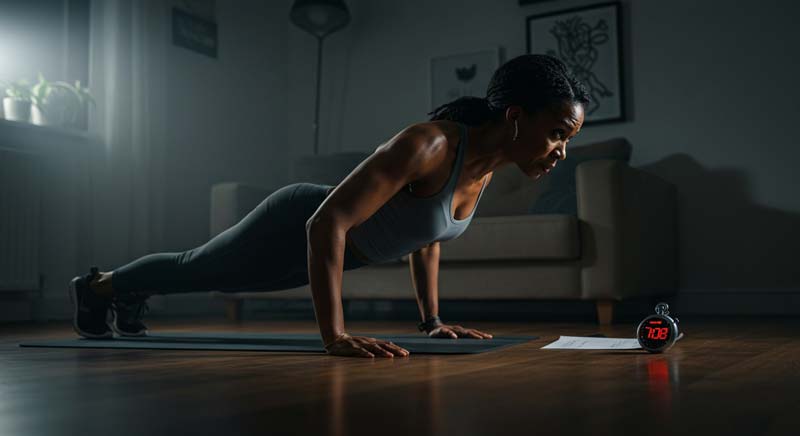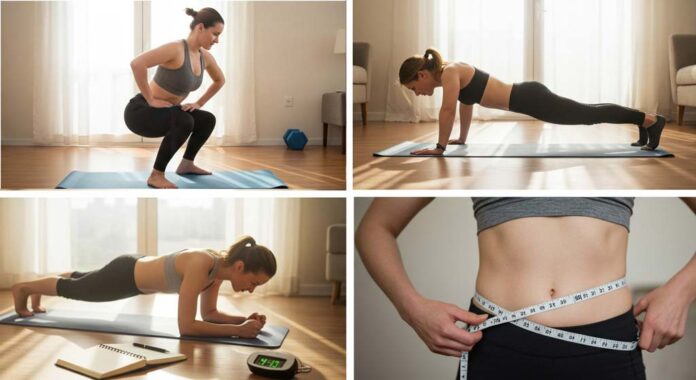Mastering simple fitness tests starts with understanding how professional athletes track their progress. While elite sports use sophisticated equipment, these principles can help anyone measure their fitness improvements. In fact, the most effective simple fitness tests often require nothing more than your body and essential household items.
Your body is exceptionally good at adapting to physical challenges. Exercising regularly makes it stronger, more flexible, and more efficient. These improvements happen gradually, making them hard to notice day-to-day. However, measuring specific aspects of your fitness can reveal these changes clearly and motivate you to keep going.
Think of fitness testing as taking photographs of your progress. Just as a series of photos can show subtle changes over time, regular measurements create a clear picture of your improving health. Research shows that people who track their fitness are likelier to stick with their exercise routine and achieve their goals.
The good news? You don’t need expensive equipment or professional training to measure your progress effectively. From testing your muscular endurance to checking your core strength, there are proven ways to assess every aspect of your fitness at home. Ready to discover how fit you really are?
Essential Simple Fitness Tests for Beginners
Your body reveals incredible stories about your health through simple fitness tests that tap into natural movement patterns. These fundamental measurements show how your muscles, heart, and joints work together during daily activities. Research from thousands of participants demonstrates that checking your fitness level helps identify key areas for growth while celebrating progress.
The power of simple fitness tests lies in capturing precise data about how your body moves. Each measurement tells part of your fitness story – from how efficiently your heart pumps blood during light exercise to how well your muscles maintain strength during repeated movements. Rather than abstract numbers, these tests translate into real-world abilities.
Before starting any test, give your body 5-10 minutes to warm up naturally. Research shows warmed muscles perform 23% more efficiently and provide more accurate readings. Your body composition includes baseline data, while your hip measurements reveal important patterns about overall fitness.
Essential items for accurate testing include:
- A stopwatch or phone timer for precise measurements
- A measuring tape for tracking body dimensions
- A flat, non-slip surface for stability exercises
- A sturdy chair or wall for supported movements
- A notebook to record your results

Testing Your Strength and Endurance
Your muscles adapt incredibly well to regular physical demands, building strength and endurance through consistent use. Simple fitness tests reveal these adaptations, showing how your body’s power systems develop over time. Research indicates that tracking strength changes motivates 68% of people to maintain their exercise routine.
The classic push-up test measures more than arm strength. It reveals core stability, shoulder health, and overall muscle coordination. Follow these steps to perform the test:
- Start in a plank position with hands slightly wider than shoulders.
- Lower until your upper arms align with the floor, then press back up.
- Continue until you can no longer maintain proper form (most adults achieve 15-25 quality push-ups before reaching this point).
- Repeat until failure, then record how many you did.
For lower body power, the squat test provides vital information about leg strength, balance, and coordination. Follow these steps to perform the test:
- Stand with feet shoulder-width apart
- Lower your body as if sitting back on a chair.
- Your knees should track over your toes while maintaining an upright chest.
- Perform continuous squats for 60 seconds (aiming for 20-30 repetitions with proper form).
- Record how many you did.
Your core stability influences every movement you make. The plank test measures this crucial fitness component. Follow these steps to perform the test:
- Position yourself on your forearms and toes, maintaining a straight line from head to heels.
- Hold this position until your form breaks (typically 30-60 seconds for beginners, while experienced exercisers might maintain it for 2-3 minutes).
- Record time.
For cardiovascular fitness, several field tests provide valuable insights:
- Walk briskly for 6 minutes, measuring the total distance covered
- Complete the 1.5-mile walk/run test, recording your time
- Try the Cooper 12-minute test, covering as much distance as possible
- Perform the Rockport One-Mile Fitness Walking Test at a steady pace
These endurance tests reveal crucial information about your heart and lung efficiency. Each test should be performed at maximum sustainable effort, stopping if you experience unusual discomfort or fatigue.
Measuring Your Body and Tracking Changes
Regular, simple fitness tests include tracking your body’s shape and size change over time. Research shows that body measurements provide more valuable information than weight alone. These simple fitness tests help identify patterns in how your body responds to exercise and nutrition.
Your waist measurement reveals significant health patterns. Using an inelastic measuring tape, measure horizontally around your waist at belly button level. Take readings first thing in the morning before eating. A healthy waist measurement typically falls below 94cm for men and 80cm for women.
For accurate hip measurements, stand with feet together and measure around the widest part of your buttocks. Always measure against bare skin or thin clothing, applying the tape snugly without compressing the tissue. Take duplicate measurements in rotation to ensure accuracy within 2.5%. Then, sum and divide them by the number of duplicates to calculate the average.
The relationship between these measurements matters significantly. Calculate your waist-to-hip ratio by dividing your waist measurement by your hip measurement. Research indicates healthy ratios should stay below:
- 0.90 for men
- 0.85 for women
- Higher ratios might indicate increased health risks
Track these measurements every 4-6 weeks, always at the same time of day. Record your numbers immediately, noting the date and time. Consider factors that might affect measurements:
- Recent meals
- Hydration levels
- Time of monthly cycle
- Previous day’s exercise
- Sleep Quality

Assessing Your Flexibility and Mobility
Understanding your flexibility helps prevent injury and improves movement quality. These simple fitness tests measure how well your joints and muscles stretch. Regular testing reveals areas needing attention while tracking your range of motion improvements.
The sit-and-reach test provides valuable information about hamstring and lower back flexibility. Sit on the floor with legs straight, reach forward towards your toes:
- Excellent: Fingers past toes
- Good: Fingers touching toes
- Fair: Fingers to mid-shin
- Needs work: Fingers only to knees. Test monthly, holding the position for 2 seconds without bouncing.
For upper body flexibility, try these proven measurements:
- Shoulder mobility: Reach one arm up and over, the other behind your back
- Trunk rotation: Sit in a chair, twist to each side, measure degrees of rotation
- Neck flexibility: Gently tilt head in each direction, noting the range of movement
Your core stability affects overall flexibility. The trunk mobility test assesses this connection:
- Stand with feet shoulder-width apart
- Place hands on hips
- Bend sideways slowly
- Measure the distance the hand slides down the leg
- Compare both sides for symmetry. Test every 4-6 weeks, always at the same time of day.
![]()
Using Simple Fitness Tests to Monitor Progress
Tracking physical changes requires consistency and attention to detail. These simple fitness tests reveal patterns in your fitness development when performed regularly. Research shows that systematic monitoring helps identify improvements and potential areas needing attention.
Creating an effective testing programme depends on several factors. Simple fitness tests work best every 4-6 weeks, allowing enough time for measurable changes while maintaining momentum. Morning testing often provides consistent results, as your body hasn’t yet faced daily physical demands.
Your testing environment plays a crucial role in accuracy:
- Choose a consistent time of day
- Use the exact location and equipment
- Maintain similar pre-test nutrition
- Allow proper rest between testing sessions
- Record environmental conditions such as temperature
Setting realistic targets requires understanding typical progress rates. Research indicates most people see measurable improvements within 6-8 weeks of regular exercise. Your body mass readings and strength measurements might show changes sooner, while endurance improvements often take longer to measure.
The science of physical adaptation reveals enthralling patterns. Each measurement tells part of an interconnected story about how your body responds to regular activity. From improved cardiovascular efficiency to enhanced muscular coordination, these changes reflect your body’s amazing ability to adapt and grow stronger.
Sources
- Ackland TR, Lohman TG, Sundgot-Borgen J, et al. Current status of body composition assessment in sport: review and position statement on behalf of the Ad Hoc Research Working Group on Body Composition Health and Performance, under the auspices of the I.O.C. Medical Commission. Sports Med. 2012:42(3):227–49.
- American Medical Association. Guides to the Evaluation of Permanent Impairment. 4th ed. Chicago (IL): American Medical Association; 1993. 339 p.
- American College of Sports Medicine. ACSM’s Guidelines for Exercise Testing and Prescription. 10th ed. Philadelphia (PA): Wolters Kluwer; 2018. 480 p.
- American College of Sports Medicine. ACSM’s Resource Manual for Guidelines for Exercise Testing and Prescription. 7th ed. Baltimore (MD): Lippincott Williams & Wilkins; 2014. 896 p.
- American College of Sports Medicine. ACSM’s Resource Manual for Guidelines for Exercise Testing and Prescription. 7th ed. Baltimore (MD): Lippincott Williams & Wilkins; 2014. 896 p.
- ATS Committee on Proficiency Standards for Clinical Pulmonary Function Laboratories. ATS statement: guidelines for the six-minute walk test. Am J Respir Crit Care Med. 2002;166(1):111–7.
- Baker MK, Atlantis E, Singh MAF. Multi-modal exercise programs for older adults. Age Ageing. 2007;36(4):375–81.
- Black GM, Gabbett TJ, Johnston RD, Cole MH, Naughton G, Dawson B. Physical fitness and peak running periods during female Australian football match-play. Science and Medicine in Football. 2018;2(3):246–251.
- Cameron AJ, Magliano DJ, Söderberg SC. A systematic review of the impact of including both waist and hip circumference in risk models for cardiovascular diseases, diabetes and mortality. Obes Rev. 2013;14:86–94.
- Castro-Piñero J, González-Montesinos JL, Mora J, et al. Percentile values for muscular strength field tests in children aged 6 to 17 years: influence of weight status. J Strength Cond Res. 2009;23(8):2295–310.
- Cook G, Burton L, Hoogenboom B. Pre-participation screening: the use of fundamental movements as an assessment of function — part 2. N Am J Sports Phys Ther. 2006;1(3):132–9.
- Duthie GM. A framework for the physical development of elite rugby union players. Int J Sports Physiol Perform. 2006;1(1):2–13.
- Fletcher GF, Ades PA, Kligfield P, et al. Exercise standards for testing and training: a scientific statement from the American Heart Association. Circulation. 2013;128:873–934.
- Garber CE, Blissmer B, Deschenes MR, et al. American College of Sports Medicine position stand. Quantity and quality of exercise for developing and maintaining cardiorespiratory, musculoskeletal, and neuromotor fitness in apparently healthy adults: guidance for prescribing exercise. Med Sci Sports Exerc. 2011;43(7):1334–59.
- Graves JE, Kanaley JA, Garzarella L, Pollock ML. Anthropometry and body composition measurement. In: Maud PJ, Foster C, editors. Physiological Assessment of Human Fitness. 2nd ed. Champaign (IL): Human Kinetics; 2006. p. 185–225.
- Jackson AW, Baker AA. The relationship of the sit and reach test to criterion measures of hamstring and back flexibility in young females. Res Q Exerc Sport. 1986;57(3):183–6.
- Lidor R, Côté J, Hackfort D. ISSP position stand: to test or not to test? The use of physical skill tests in talent detection and in early phases of sport development. Int J Sport Exerc Psychol. 2009;7(2):131–146.
- Liemohn WP, Sharpe GL, Wasserman JF. Lumbosacral movement in the sit-and-reach and in Cailliet’s protective-hamstring stretch. Spine (Phila Pa 1976). 1994;19(18):2127–30.
- Pickering TG, Hall JE, Appel LJ, et al. Recommendations for blood pressure measurement in humans and experimental animals: part 1: blood pressure measurement in humans: a statement for professionals from the Subcommittee of Professional and Public Education of the American Heart Association Council on High Blood Pressure Research. Hypertension. 2005;45:142–61.
- Rikli RE, Jones CJ. Development and validation of criterion-referenced clinically relevant fitness standards for maintaining physical independence in later years. Gerontologist. 2013;53(2):255–67.
- Santanasto AJ, Newman AB, Strotmeyer ES, Boudreau RM, Goodpaster BH, Glynn NW. Effects of changes in regional body composition on physical function in older adults: a pilot randomized controlled trial. J Nutr Health Aging. 2015;19:913–21.
- Storer TW, Davis HA, Caiozzo VJ. Accurate prediction of VO2max in cycle ergometry. Med Sci Sports Exerc. 1990;22:704–12.
- Thibault R, Genton L, Pichard C. Body composition: why, when and for who? Clin Nutr. 2012;31:435–47.
- Wind AE, Takken T, Helders PJ, Engelbert RH. Is grip strength a predictor for total muscle strength in healthy children, adolescents, and young adults? Eur J Pediatr. 2010;169(3):281–7.
- World Health Organization. Waist Circumferences and Waist-hip Ratio: Report of WHO Expert Consultation. Geneva (Switzerland): World Health Organization; 2008. 39 p.



